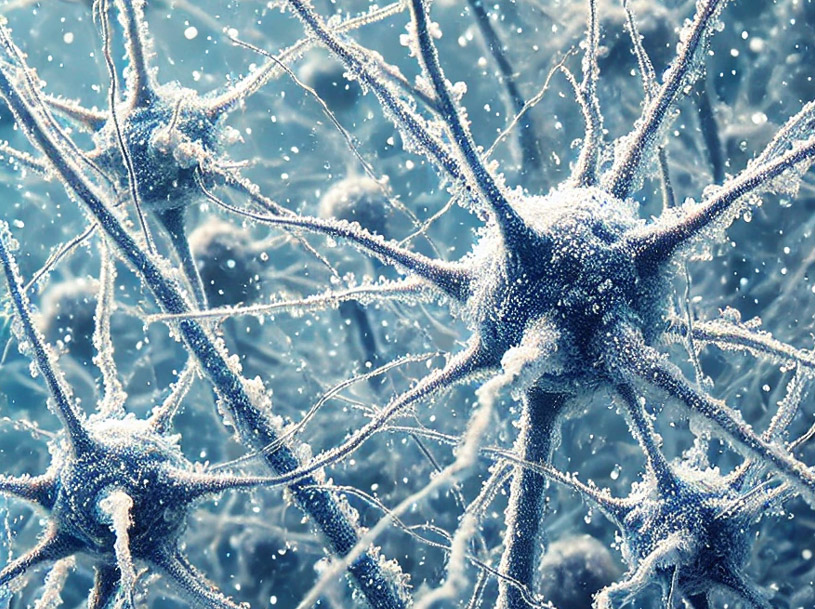
15th February 2025 Cryopreservation breakthrough: mouse brain tissue revived Scientists have successfully revived mouse brain tissue after storage at –150°C for a week – reactivating near-normal function – a notable breakthrough in cryopreservation.
For decades, cryopreservation has been a staple of science fiction – from deep-space voyages in 2001: A Space Odyssey and Aliens, to suspended animation in futuristic medical treatments. The concept of freezing and later reviving a human body without damage has long fascinated scientists, transhumanists, and the public alike. While no full-body revival has ever been attempted, cryogenic science has made steady progress. Today, nearly 250 people are preserved in a frozen state at the Alcor Life Extension Foundation in the United States, while thousands more are signed up to undergo the procedure after their death. These individuals have placed their faith in future medical advancements, hoping that their brains – and perhaps even their consciousness – could one day be restored. Major technical challenges remain, however. Ice formation can cause irreparable damage to delicate tissues, and reviving a brain without destroying its intricate neural networks has, until now, been beyond our reach. A new study, by researchers at the University of Erlangen-Nuremberg in Germany, has brought the realm of science fiction a step closer to reality. It used a cutting-edge vitrification technique to cool mouse brain tissue in a way that avoided the formation of damaging ice crystals, almost fully preserving both its structure and function. Unlike previous studies, which have struggled to restore viable neural activity, this latest research demonstrated that the brain's complex electrical signals and synaptic connections can be successfully revived, even after deep freezing. Led by corresponding author Alexander German, the researchers experimented with different combinations of cryoprotectant fluids, eventually producing one called V3. This contained a mixture of dimethyl sulfoxide, formamide, and ethylene glycol. They then developed a method to minimise toxicity, osmotic shrinking, and other potential damage. The researchers took samples from adult mouse hippocampal slices. The hippocampus, found in all vertebrate brains, enables the consolidation of information from short-term to long-term memory, and spatial memory that enables navigation. After careful preparation, the process began with each piece of brain tissue being placed on a polyester mesh, exposed to rapidly rising concentrations of cryoprotectant fluid at 10°C, followed by –10°C. Next, the samples underwent directional cooling from a cylinder of liquid nitrogen below them. After one minute in this position, they were gently lowered down into the freezing liquid. This gradual movement prevented physical cracking from thermomechanical stress. Having reached –196°C, water within the brain tissue transformed into a glass-like, amorphous state – a phenomenon known as vitrification. The researchers then transferred the samples to a freezer at –150°C and kept them in storage for a week.
Thawing of the brain tissue involved reversing the procedure with great care. First, the team removed each sample from the freezer, then held them briefly in liquid nitrogen again, before placing them back onto the cylinder top, then rewarmed them in V3 solution at –10°C. To prevent osmotic shock, the researchers gradually decreased the V3 cryoprotectant and replaced it with artificial cerebrospinal fluid (aCSF) containing mannitol, as shown by the dashed line in the diagram above. They then incubated each slice at room temperature, allowing it to fully recover before testing. The revived brain slices demonstrated near-normal electrical activity and maintained key neural functions. Crucially, the team recorded synaptic responses – connections between neurons – and observed long-term potentiation, an essential process underlying learning and memory. Unlike previous studies that often focused solely on preserving the structure of brain tissue but struggled to maintain its functional viability, this new study showed that it is possible to pause and later revive the brain's complex activity almost entirely intact. In the context of recent developments, it is worth noting that in 2021, rat hearts were successfully revived after vitrification, followed by rat livers in 2022 and then rat kidneys in 2023. "And our work now shows that it is also possible to cryopreserve rodent brain tissue slices," said German. "So this is leaving some room for optimism that it would be possible to cryopreserve the whole brain, and also the whole rodent organism, at some point. I personally do believe that it is possible to cryopreserve a whole human and that this could have beneficial applications if done responsibly." Aside from the potential implications for immortality, and getting to experience the world centuries or millennia from now, a freezing and revival process could benefit human medicine in the more immediate future. For instance, imagine doctors being able to pause a brain's activity during critical situations – such as major surgeries or after severe injuries, thereby buying precious time. This could also revolutionise organ preservation, making it possible to store organs or tissues for much longer periods until a perfect match is found for transplantation. Moreover, even if the improved method is initially limited to slices rather than whole brains, it would still be highly useful. In current practice, brain slices used for research typically survive for only 10 hours. Being able to store and later revive these slices could greatly enhance the ability to study neurological conditions, test new treatments, and facilitate the sharing of valuable brain samples between laboratories for further analysis. While much more work is needed, the results from German's team provide a promising foundation for further exploration. The detailed protocol they developed offers a blueprint that future studies could refine and adapt for larger, more complex tissues. In everyday terms, their study has revealed that brains may be more resilient than previously thought, opening up exciting possibilities not only for medicine but also for our understanding of life itself.
Comments »
If you enjoyed this article, please consider sharing it:
|
||||||








